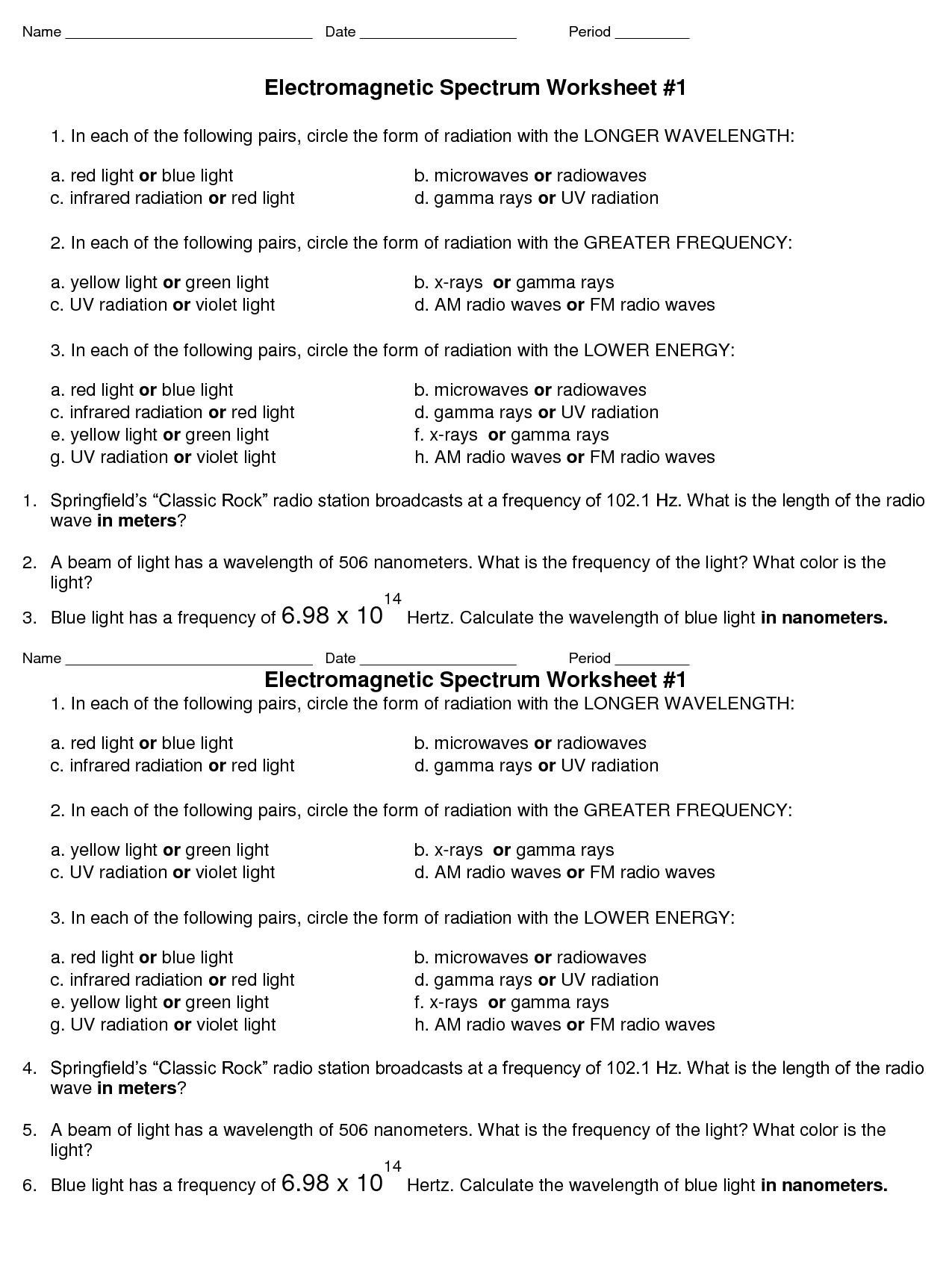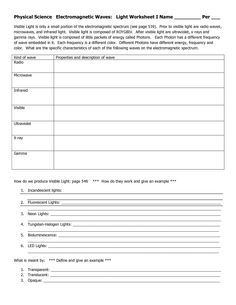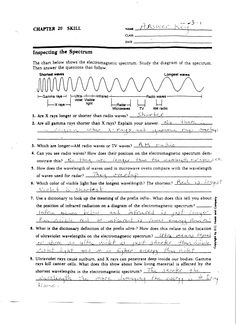EM Spectrum Worksheet
Are you looking for a comprehensive learning resource to understand the electromagnetic spectrum? Look no further! Our EM Spectrum Worksheet is designed to provide students with a clear and concise overview of this fascinating subject. With carefully crafted questions and engaging activities, this worksheet is perfect for middle and high school students who want to deepen their understanding of the different types of waves that make up the electromagnetic spectrum.
Table of Images 👆
More Other Worksheets
Kindergarten Worksheet My RoomSpanish Verb Worksheets
Cooking Vocabulary Worksheet
DNA Code Worksheet
Meiosis Worksheet Answer Key
Art Handouts and Worksheets
7 Elements of Art Worksheets
All Amendment Worksheet
Symmetry Art Worksheets
Daily Meal Planning Worksheet
What is the electromagnetic spectrum?
The electromagnetic spectrum is the range of all frequencies of electromagnetic radiation, from high-frequency gamma rays and X-rays to low-frequency radio waves. It includes all types of electromagnetic radiation, each with different properties, such as wavelength and energy level, used in various applications like communication, imaging, and heating.
What are the different types of waves in the electromagnetic spectrum?
The electromagnetic spectrum consists of various types of waves, including radio waves, microwaves, infrared waves, visible light, ultraviolet waves, X-rays, and gamma rays. Each type of wave has a different wavelength and frequency, with radio waves having the longest wavelength and lowest frequency, while gamma rays have the shortest wavelength and highest frequency.
How do the wavelengths of electromagnetic waves vary across the spectrum?
The wavelengths of electromagnetic waves vary across the spectrum, with shorter wavelengths corresponding to higher frequencies and energy levels, and longer wavelengths corresponding to lower frequencies and energy levels. Starting from shortest to longest wavelengths, the electromagnetic spectrum progresses from gamma rays, X-rays, ultraviolet, visible light, infrared, microwaves, and radio waves. Each type of electromagnetic wave has its own unique range of wavelengths and properties, playing a crucial role in various phenomena and applications across physics, chemistry, biology, and technology.
How does the frequency of electromagnetic waves vary across the spectrum?
The frequency of electromagnetic waves varies across the spectrum in an inversely proportional manner to the wavelength, meaning that as the wavelength decreases, the frequency increases. This relationship is known as the wavelength-frequency relationship and is a key characteristic of electromagnetic waves. The spectrum ranges from low-frequency radio waves to high-frequency gamma rays, with each type of wave having a unique frequency that determines its position within the spectrum.
Give an example of a practical application for each type of wave in the electromagnetic spectrum.
Radio waves are used in communication systems such as radio and television broadcasting. Microwaves are used in microwave ovens for cooking food quickly and efficiently. Infrared waves are used in remote controls for TVs and other electronic devices. Visible light is used for vision and photography. Ultraviolet waves are used in medical applications for sterilization and treating skin conditions. X-rays are used in medicine for imaging bones and tissues. Gamma rays are used in cancer treatment to target and destroy tumor cells.
How are electromagnetic waves generated?
Electromagnetic waves are generated by the acceleration of charged particles. When charged particles, such as electrons, are accelerated, they create changing electric fields, which in turn create changing magnetic fields. These changing electric and magnetic fields propagate through space as electromagnetic waves at the speed of light.
How do electromagnetic waves interact with matter?
Electromagnetic waves interact with matter through processes such as absorption, transmission, reflection, and scattering. When electromagnetic waves encounter matter, the atoms and molecules within the material can absorb the energy of the waves, causing them to vibrate. This absorption can result in heating of the material. Some of the energy can also be transmitted through the material, while some can be reflected off its surface. Additionally, the waves can be scattered in various directions depending on the properties of the material, leading to phenomena like refraction and diffraction.
What is the speed of electromagnetic waves in a vacuum?
The speed of electromagnetic waves in a vacuum is approximately 299,792 kilometers per second, which is commonly rounded to 300,000 kilometers per second.
How does the energy of electromagnetic waves change across the spectrum?
The energy of electromagnetic waves increases as you move across the spectrum from lower frequencies to higher frequencies. This is because the energy of a wave is directly proportional to its frequency, as shown in the equation E = hf, where E is energy, h is Planck's constant, and f is frequency. Therefore, gamma rays, at the high-frequency end of the spectrum, have the highest energy, while radio waves, at the low-frequency end, have the lowest energy.
What are some ways in which we use electromagnetic waves in everyday life?
Electromagnetic waves are used in everyday life in numerous ways, such as in communication devices like cell phones, radios, and television broadcasts, as well as in wireless internet networks. They are also used in medical applications like MRI machines for imaging, thermal imaging cameras for detecting heat signatures, and security systems like metal detectors and airport scanners. Additionally, electromagnetic waves are essential in cooking appliances like microwaves and in transportation systems such as radar for air traffic control and electromagnetic levitation in high-speed trains.
Have something to share?
Who is Worksheeto?
At Worksheeto, we are committed to delivering an extensive and varied portfolio of superior quality worksheets, designed to address the educational demands of students, educators, and parents.




































Comments